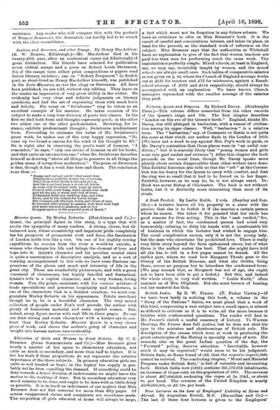Education of Girls and Women in Great Britain. By C.
S. Bremner. (Swan Sonnenechein and Co.)—Misr Bremner gives nearly a quarter of her space to elementary education, not quite as much to secondary, and more than half to higher. It is not her fault if these proportions do not represent the relative importance of the three subjects. In primary education girls are quite as well treated as boys ; in the higher the supply is pro- bably not far from equalling the demand. If something could be done towards a fairer division of endowments we might leave the matter to the working of time. But in secondary education very much remains to be done, and ought to be done with as little delay as possible. It is in itself an indictment of our neglect that Miss Bremner does not find material for more than fifty pages. Of course exaggerated claims and complaints are sometimes made. The proportion of girls educated at home will always be large,
a fact which must not be forgotten in any future scheme. We have no criticisms to offer on Miss Bremner's book. It is the result of careful and conscientious labours, and takes its place, at least for the present, as the standard work of reference on the subject. Miss Bremner says that the authorities at Whitehall have no explanation to give of the fact that women teachers are paid less than men for performing much the same work. The explanation is perfectly simple. Mixed schools, at least in England, are, we may say, invariably taught by women, and the mixed schools are always small ones. Such tables of comparative salaries as are given on p. 44, where the Church of England average works out at £121 for masters and £75 for mistresses, against a Board- school average of £162 and £114 respectively, should always be accompanied with an explanation. We have known Church managers reproached with the smaller average of the salaries they paid.


































 Previous page
Previous page